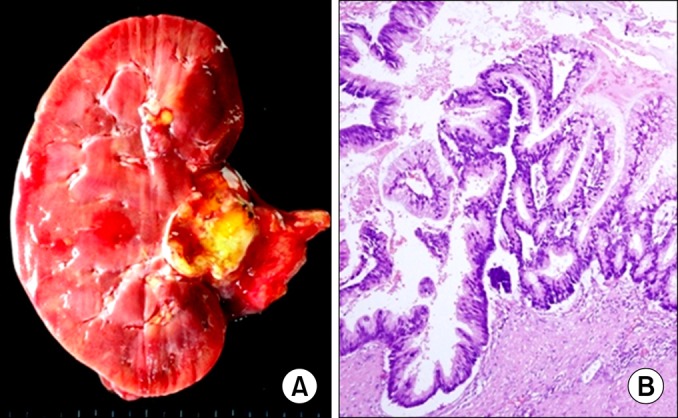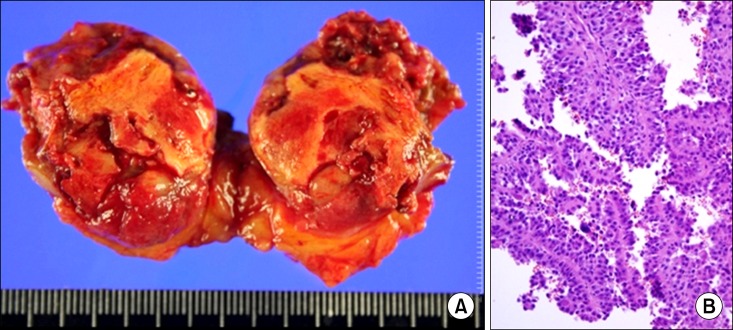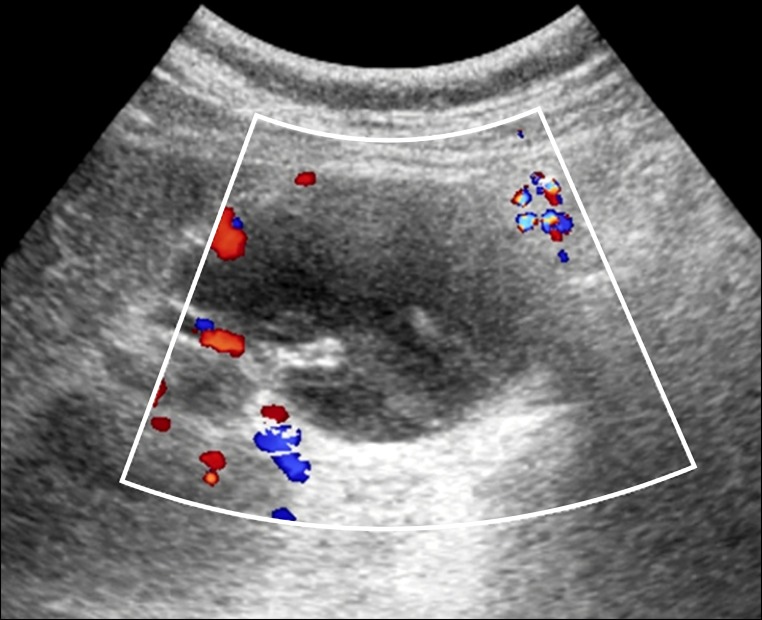Abstract
The Bosniak renal cyst classification has been accepted by urologists and radiologists as a way of diagnosing cystic renal masses and determining the management approach. We report two cases of a renal cystic mass that showed a category change from category II on the basis of enhanced computed tomography to category IV after further gadolinium-enhanced magnetic resonance imaging. In both cases, the cysts were later confirmed as kidney cancer by pathology.
Keywords: Cysts, Kidney, Magnetic resonance imaging
Since its initial introduction in 1986, many urologists have used the Bosniak classification for the diagnosis of cystic renal masses and for planning treatment [1-3]. The Bosniak classification was developed on the basis of computed tomography (CT), but it is also an effective method for use when evaluating by magnetic resonance (MR) imaging [4,5]. Here we report two cases of a renal cystic mass that showed a category change from category II on the basis of CT imaging to category IV after further MR imaging evaluation. In both cases, the masses were later confirmed as malignancies by pathology.
CASE REPORT
Case 1
A 69-year-old female visited the nephrology clinic owing to microscopic hematuria detected by a routine health check-up. A CT scan revealed a 3.3×3.0 cm slightly highly attenuated cyst in the lower pole of the right kidney on the precontrast image, which had no enhancement (Fig. 1A and 1B). The cyst was compatible with a Bosniak category II renal cyst. However, some portions of the renal cyst were enhanced on the gadolinium-enhanced T1-weighted MR image (Fig. 1C). Under the impression of renal cell carcinoma (RCC), partial nephrectomy was performed. The gross specimen was a yellowish solid mass that microscopically was compatible with papillary type RCC, Fuhrmann nuclear grade III (Fig. 2). The patient was discharged without complications.
FIG. 1.
(A) Computed tomography demonstrated a 3.3×3.0 cm slightly highly attenuated cyst in the lower pole of the right kidney on the precontrast image (B) that had no enhancement. (C) The gadolinium-enhanced T1-weighted magnetic resonance image showed an enhancing lesion in the renal cyst (arrow).
FIG. 2.
(A) Partial nephrectomy specimen showed a yellowish solid portion in the cystic mass (B) that was compatible with papillary type renal cell carcinoma, Fuhrmann nuclear grade III (H&E, ×200).
Case 2
A 42-year-old female visited the nephrology clinic because of an incidental renal cyst detected by ultrasonography. The cyst showed internal calcification and amorphous echogenic portions without definite solid mass or increased vascularity (Fig. 3). A CT scan demonstrated a 3.7×3.5×7.2 cm ovoid-shaped cystic lesion medially located in the mid portion of the right kidney, which showed calcifications that were not contrast-enhancing (Fig. 4A and 4B). On the basis of these findings, the patient was diagnosed with a Bosniak category II renal cyst. However, T1-weighted gadolinium-enhanced MR imaging demonstrated an enhancing portion in the cyst compatible with Bosniak category IV (Fig. 4C). Radical nephrectomy was then performed and the pathologic examination revealed a yellowish solid mass with mucinous material that was microscopically compatible with mucinous adenocarcinoma (Fig. 5). At present, the patient has remained stable for 3 years postoperatively.
FIG. 3.
Doppler ultrasonography demonstrated an approximately 6-cm ovoid-shaped cyst with internal calcification and amorphous echogenic portions without a definite solid mass or increased vascularity.
FIG. 4.
(A) Computed tomography scan demonstrated a 3.7×3.5×7.2 cm ovoid-shaped cystic lesion medially located in the mid portion of the right kidney, which showed calcifications (B) that were not contrast enhancing. (C) T1-weighted gadolinium-enhanced magnetic resonance imaging demonstrated an enhancing portion in the cyst (arrow).
FIG. 5.

(A) Nephrectomy specimen revealed a yellowish solid mass with mucinous material. (B) Microscopy showed closely packed mucinous glands with nuclear stratification and hyperchromatism, compatible with mucinous adenocarcinoma (H&E, ×200).
DISCUSSION
The Bosniak classification for cystic renal masses was first introduced in 1986, and many urologists and radiologists use the classification as a means of assessing and managing cystic renal disease, with general agreement between observers in most cases [1-3]. During the past two decades, the Bosniak classification has been updated and refined [6,7]. Although the Bosniak classification was developed on the basis of CT findings, it is also commonly applied with the use of other imaging modalities [8]. MR imaging is useful for characterizing complex cystic renal masses because the vascularity (enhancement) of a lesion can be evaluated, and it has been shown that the Bosniak classification can be applied to MR imaging [9]. It should be noted that MR imaging has better contrast resolution compared with CT, and occasionally there will be findings on MR imaging scans that are not correlative with CT images [8]. Israel et al. [5] compared the findings of both CT and MR imaging in the evaluation of cystic renal masses by using the Bosniak classification system. In their series, the enhancement characteristics during CT and MR imaging differed in 2 (3%) of the 69 lesions. The first was a cyst that contained a mural nodule, which was enhanced by 13 HU on CT after intravenous contrast material administration. Although it was believed during CT that this lesion represented a hypovascular neoplasm, MR imaging showed definitive enhancement in the mural nodule, a finding that supported a diagnosis of malignancy. The second lesion was characterized as category IIF by CT and had a thick calcified wall. However, on MR imaging, the wall of the lesion appeared enhanced, thicker, and more irregular, and the lesion was characterized as category III. This lesion proved to be a hemorrhagic cyst during the pathologic examination [5].
Placing a lesion into a specific category can be difficult in some cases, in particular, differentiating between category IIF and III. Our cases displayed a renal cystic mass that showed a category change from category II on the basis of CT imaging to category IV after further MR imaging evaluation. In both cases, the masses were later confirmed to be malignancies by pathology. One factor that has not changed since the inception of the Bosniak classification system is the importance of lesion enhancement. The most important criterion used to differentiate surgical lesions from nonsurgical lesions is the presence or absence of tissue vascularity (enhancement) [8]. Our two patients were diagnosed with the papillary type of RCC and mucinous adenocarcinoma, respectively. These cases were relatively hypovascular tumors compared with the clear cell-type RCC, which may result in difficulties in accurate diagnosis based on enhanced CT. The superior contrast resolution of MR imaging may be ideal for the further characterization of renal lesions categorized as II and IIF by CT. Additional studies are necessary to establish the significance of these findings.
Inci et al. [10] have reported that diffusion-weighted imaging may help to differentiate benign and malignant renal tumors and could be added to routine kidney MR imaging protocols. This technique could potentially be used as an additional parameter to help to determine appropriate clinical management. Also, measuring the signal intensities of trace diffusion images and apparent diffusion coefficient values may be useful for subgrouping renal cysts.
Footnotes
The authors have nothing to disclose.
References
- 1.Bosniak MA. The current radiological approach to renal cysts. Radiology. 1986;158:1–10. doi: 10.1148/radiology.158.1.3510019. [DOI] [PubMed] [Google Scholar]
- 2.Curry NS, Cochran ST, Bissada NK. Cystic renal masses: accurate Bosniak classification requires adequate renal CT. AJR Am J Roentgenol. 2000;175:339–342. doi: 10.2214/ajr.175.2.1750339. [DOI] [PubMed] [Google Scholar]
- 3.Koga S, Nishikido M, Inuzuka S, Sakamoto I, Hayashi T, Hayashi K, et al. An evaluation of Bosniak's radiological classification of cystic renal masses. BJU Int. 2000;86:607–609. doi: 10.1046/j.1464-410x.2000.00882.x. [DOI] [PubMed] [Google Scholar]
- 4.Balci NC, Semelka RC, Patt RH, Dubois D, Freeman JA, Gomez-Caminero A, et al. Complex renal cysts: findings on MR imaging. AJR Am J Roentgenol. 1999;172:1495–1500. doi: 10.2214/ajr.172.6.10350279. [DOI] [PubMed] [Google Scholar]
- 5.Israel GM, Hindman N, Bosniak MA. Evaluation of cystic renal masses: comparison of CT and MR imaging by using the Bosniak classification system. Radiology. 2004;231:365–371. doi: 10.1148/radiol.2312031025. [DOI] [PubMed] [Google Scholar]
- 6.Israel GM, Bosniak MA. Calcification in cystic renal masses: is it important in diagnosis? Radiology. 2003;226:47–52. doi: 10.1148/radiol.2261011704. [DOI] [PubMed] [Google Scholar]
- 7.Israel GM, Bosniak MA. Follow-up CT of moderately complex cystic lesions of the kidney (Bosniak category IIF) AJR Am J Roentgenol. 2003;181:627–633. doi: 10.2214/ajr.181.3.1810627. [DOI] [PubMed] [Google Scholar]
- 8.Israel GM, Bosniak MA. MR imaging of cystic renal masses. Magn Reson Imaging Clin N Am. 2004;12:403–412. doi: 10.1016/j.mric.2004.03.006. [DOI] [PubMed] [Google Scholar]
- 9.Israel GM, Bosniak MA. An update of the Bosniak renal cyst classification system. Urology. 2005;66:484–488. doi: 10.1016/j.urology.2005.04.003. [DOI] [PubMed] [Google Scholar]
- 10.Inci E, Hocaoglu E, Aydin S, Cimilli T. Diffusion-weighted magnetic resonance imaging in evaluation of primary solid and cystic renal masses using the Bosniak classification. Eur J Radiol. 2012;81:815–820. doi: 10.1016/j.ejrad.2011.02.024. [DOI] [PubMed] [Google Scholar]






